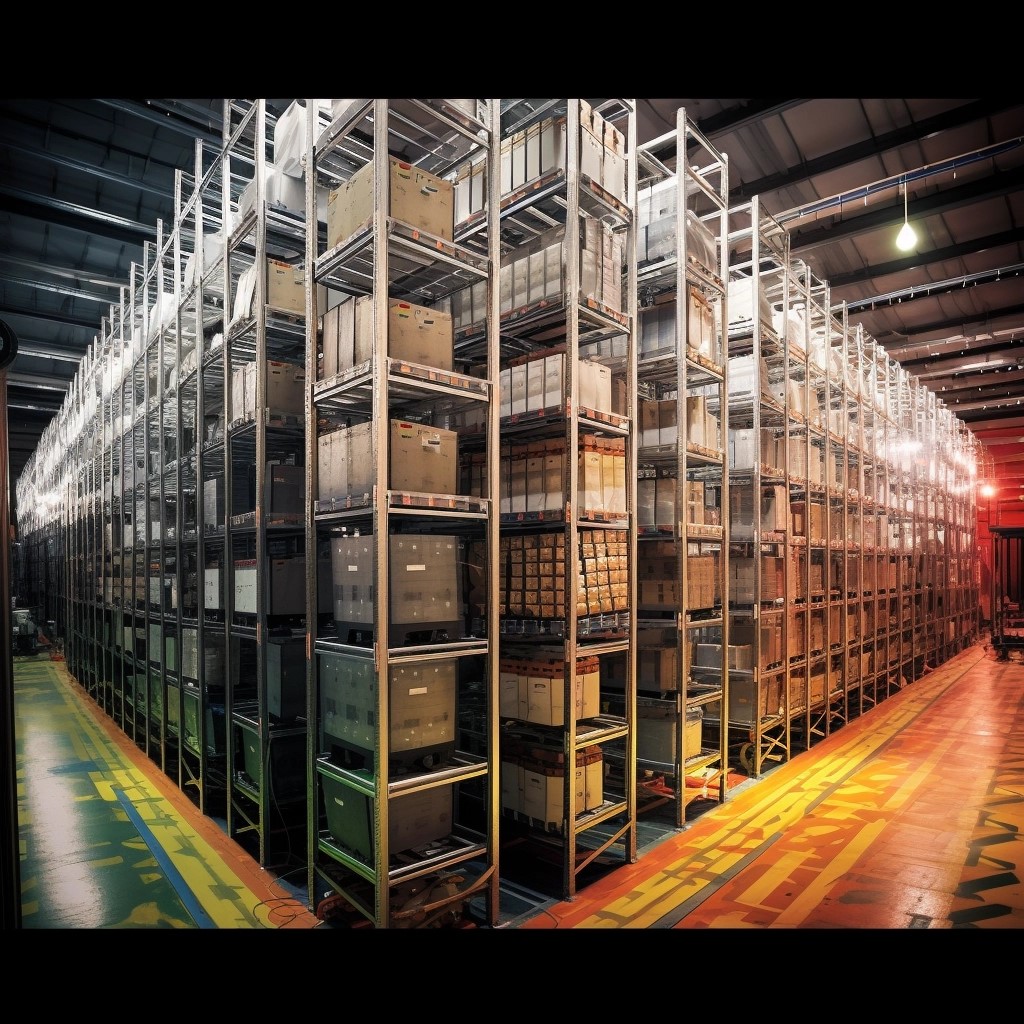
Many warehouse managers struggle with optimizing storage space while ensuring easy access and inventory management.
Drive-in racks have gained prominence for their ability to solve certain storage problems.
This article will help you figure out whether they’re right for you. We’ll cover what drive-in racks are, their components, their advantages and disadvantages, and best practices for implementation.
What is a Drive-In Rack?
Drive-in racks are a type of high-density storage system designed to maximize the use of available space in a warehouse.
These racks are characterized by their structural configuration, allowing forklifts to drive directly into the rack structure to access pallets. Unlike traditional racks, drive-in racks eliminate the need for aisles between storage sections, making them particularly suitable for storing large quantities of homogeneous products with low turnover rates.
The components of a drive-in rack system include vertical frames, horizontal beams, pallet rails, and guide rails. The vertical frames support the structure, while the horizontal beams connect the frames, forming a series of bays.
Pallet rails, positioned within the bays, provide the surface on which pallets are placed. Guide rails along the pallet rails guide forklifts during loading and unloading processes.
Drive-in racks are ideal for goods with a Last-In-First-Out (LIFO) inventory management system, where the latest items stored are the first to be retrieved. This makes them suitable for products with a low shelf life or those requiring specific storage conditions, such as perishable goods or products with expiration dates.
Drive-In Racking Systems vs. Other Racks
To determine whether drive-in racks are the right choice for your project, it’s essential to compare them with other common rack systems — like Selective Racks, Push Back Racks, and Flow Racks.
Selective Racks, the most traditional option, offer accessibility to every pallet individually. While they provide excellent selectivity, they may not be as space-efficient as drive-in racks. Push Back Racks allow for multiple pallets to be stored on a single level, with each subsequent pallet pushing the previous one back. Flow Racks, on the other hand, use gravity to move pallets along rollers, ensuring a First-In-First-Out (FIFO) system.
Comparatively, drive-in racks stand out for their ability to maximize storage space at the cost of selectivity. They are best suited for warehouses dealing with large quantities of the same product and a LIFO inventory system.
Drive-In Rack Advantages
One of the primary advantages of drive-in racks is their efficiency in loading and unloading. Forklifts can enter the rack structure, allowing for quick and direct access to pallets. This feature is particularly beneficial for warehouses with a high volume of pallet movements.
Moreover, drive-in racks contribute to a reduction in labor costs. The elimination of aisles between storage sections means fewer pathways for forklifts, reducing the need for additional labor to navigate and transport goods within the warehouse. This efficiency translates into time savings and increased productivity.
Another notable advantage is the space optimization achieved through the elimination of aisles. Drive-in racks can store a larger quantity of products in the same footprint compared to traditional rack systems. This is especially valuable for warehouses where space is a premium and every square foot matters.
Drive-In Rack Disadvantages
While drive-in racks offer several advantages, they also come with inherent disadvantages that need to be considered. One significant drawback is the limited selectivity they provide. Since the LIFO system is inherent to drive-in racks, accessing pallets in the middle or rear positions may require the removal of front pallets, impacting accessibility.
Additionally, drive-in racks may not be suitable for products with high turnover rates. The LIFO system makes them less efficient for goods with a short shelf life or those requiring a FIFO system. Therefore, businesses with rapidly changing inventory may find other rack systems more suitable.
Drive-In Rack Implementation and Best Practices
Implementing drive-in racks requires careful planning and adherence to best practices to ensure optimal performance and safety. Here are key steps for planning and designing a warehouse layout with drive-in racking:
- Assess Storage Needs: Understand the type of products you handle, their turnover rates, and storage requirements. Drive-in racks are most effective for large quantities of homogeneous goods with low turnover.
- Consider Space Constraints: Evaluate available space in the warehouse. Drive-in racks maximize storage but require ample space for forklift maneuverability and safety.
- Safety Protocols: Implement stringent safety protocols for forklift operators. Provide training on navigating within drive-in racks, especially considering reduced visibility inside the structure.
- Regular Inspections: Establish a routine inspection schedule for drive-in racks. Check for any signs of damage, wear, or structural issues. Promptly address any concerns to maintain the integrity of the system.
- Proper Maintenance: Ensure regular maintenance of forklifts and other equipment used in conjunction with drive-in racks. Well-maintained equipment contributes to smooth operations and reduces the risk of accidents.
- Loading and Unloading Procedures: Develop standardized procedures for loading and unloading pallets. Proper organization and adherence to these procedures enhance efficiency and minimize errors.
- Emergency Preparedness: Have contingency plans in place for emergencies. This includes procedures for evacuating personnel, addressing structural damage, and ensuring the safety of stored goods.
In conclusion, drive-in racks offer a unique storage solution that can significantly benefit warehouses dealing with large quantities of similar products.
But their suitability depends on the specific needs and characteristics of the goods being stored. By carefully considering the advantages, disadvantages, and implementing best practices, you make informed decisions and upgrade your warehouse operations.
Did You Know You Can Create Winning Drive-In Rack Prelims, All by Yourself?
With OneRack, you can get drive-in rack prelims approved in minutes. No more days of back-and-forth with engineers.
You can tweak the prelims in the app until you get it how you want, and then you can send the finished product off for a permit. It’s free to try for 30 days with this link.
Try OneRack’s Pro Version, Completely Free
Get a 30-day free trial and start creating approved rack prelims within minutes.
